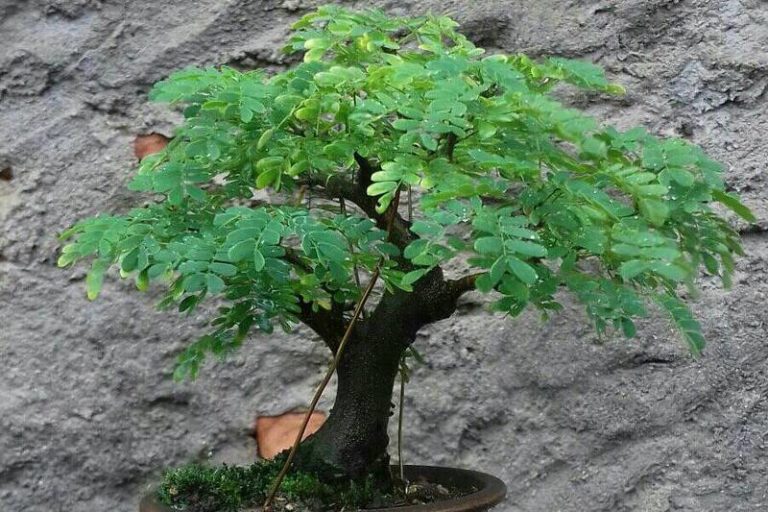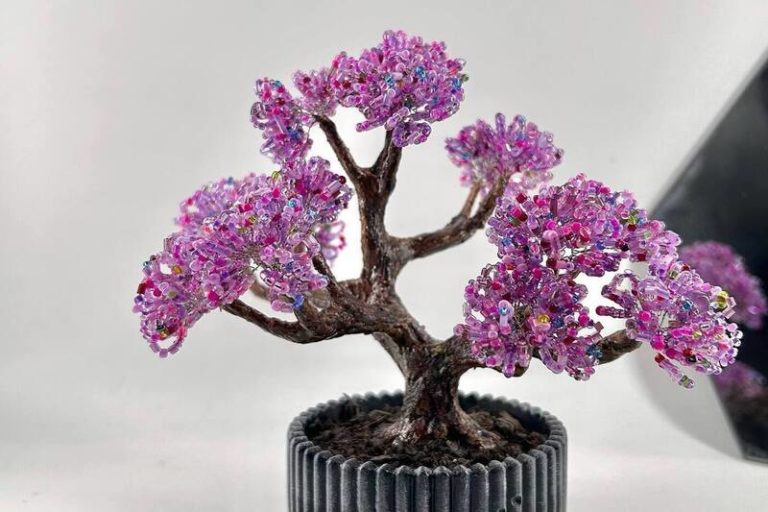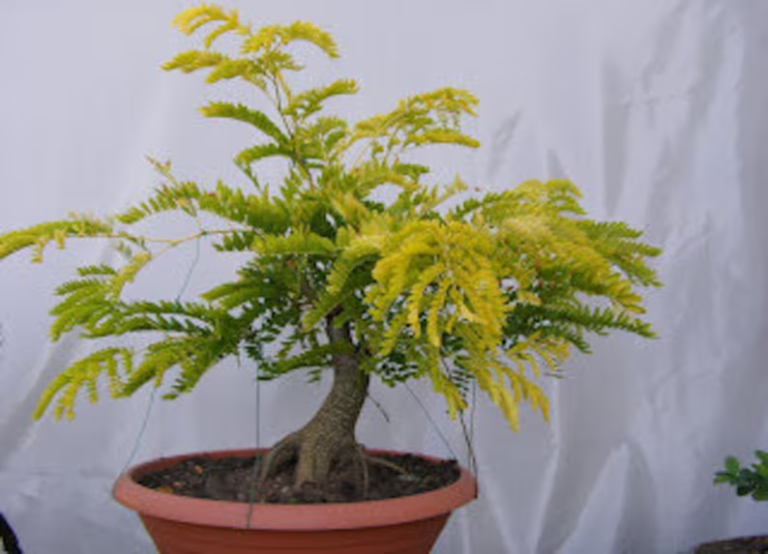Virginia Creeper Bonsai: Preserving the Essence of Nature in a Pot
People have been enchanted by the tiny beauty and meaning of bonsai trees. The Virginia Creeper is one of these beautiful bonsai plants. In this article, we’ll look into the world of Virginia Creeper Bonsai and learn about its features, how to grow it, how to care for it, and design ideas.
What is a Virginia Creeper Bonsai?
A Virginia Creeper Bonsai is a small form of the Parthenocissus quinquefolia plant, also known as the Virginia Creeper. It is grown and trained in the art of bonsai. The Virginia Creeper is a climber plant that grows in North America. It is known for its bright green leaves that turn beautiful shades of red, orange, or purple in the fall. When the Virginia Creeper is grown as a bonsai, it is trimmed, shaped, and styled to make a small tree with complex branches and leaves that look like a full-sized tree. Virginia Creeper Bonsai can be a beautiful addition to a yard or bonsai collection. They are a unique mix of natural beauty and artistic expression.
History and Origins of the Virginia Creeper Bonsai
How and why the Virginia Creeper came to be Bonsai goes back to the old art of bonsai, which began in China more than a thousand years ago and then spread to Japan. Bonsai, which means “tray planting” in Japanese, is the art of growing and training trees or plants in pots to make tiny landscapes.
The exact history of the Virginia Creeper Bonsai is not well known, but it is thought that it became a bonsai species because people liked making bonsai trees out of different kinds of plants. Bonsai fans were drawn to the Virginia Creeper because of its beautiful leaves and ability to grow well as a bonsai.
As bonsai became more popular across the world, aficionados sought for new and different plant species to nurture as bonsai. Because it is native to North America and is abundantly available, the Virginia Creeper has become a popular option among bonsai artists trying to build unusual and visually beautiful miniature trees.
To train the Virginia Creeper into bonsai form, bonsai practitioners experimented with various procedures including as pruning, shaping, and wiring over time. They were able to create elaborate and intriguing designs by carefully managing the plant’s development, emphasizing the inherent beauty of the Virginia Creeper.
Today, the Virginia Creeper Bonsai continues to be cultivated and appreciated by bonsai enthusiasts and collectors worldwide. Its rich history within the bonsai community reflects the ongoing exploration and creativity of bonsai artists, who continually seek new plant species to transform into miniature living artworks.
Virginia Creeper Bonsai and Their Symbolism
Virginia Creeper Bonsai, like many other bonsai trees, carries symbolism and meaning that adds depth to their aesthetic appeal. Here are some common symbolic associations attributed to Virginia Creeper Bonsai:
Adaptability: Virginia Creeper is well-known for its robustness and adaptability. As a bonsai, it represents adaptability, hardiness, and the ability to thrive despite adverse conditions. It’s a constant reminder that we have the fortitude and flexibility to go over whatever challenge we face.
Balance and Harmony: Overall, bonsai represents a harmonious coexistence of natural processes and human manipulation. Creeper, Virginia Graceful and delicate bonsai leaf is a reflection of the artist’s ability to bring forth the plant’s inherent beauty. It symbolizes the peaceful coexistence of humanity and the natural world.
Seasons of Life: As the seasons change, the leaves of the Virginia Creeper turn different colors to show the flow of life. The bright green leaves show growth and vigor, while the red, orange, and purple colors of fall show how time passes and the beauty of change. It reminds us to enjoy the passing times and enjoy the different stages of life.
Connection to Nature: Bonsai, like a Virginia Creeper Bonsai, brings people closer to nature. People are informed of how they are linked to nature by growing and taking care of these small trees. The Virginia Creeper Bonsai shows how important it is to care for and protect our environment. It helps people feel responsible and appreciate the beauty of nature.
Tranquility and Serenity: People often think of peace and quiet when they think of the art of bonsai. With its calm presence and beautiful shape, a Virginia Creeper bonsai makes its surroundings feel calm and peaceful. It makes you pay attention and think, giving you a peaceful place to focus on when you meditate or making any area feel calm.
Overall, Virginia Creeper Bonsai has meanings that speak to what it is like to be human and how we relate to nature. It makes us think about flexibility, balance, the seasons of life, our relationship to nature, and the search for peace. When you own and care for a Virginia Creeper Bonsai, it can remind you of these deep ideas and make you appreciate the beauty and meaning of the art of bonsai even more.
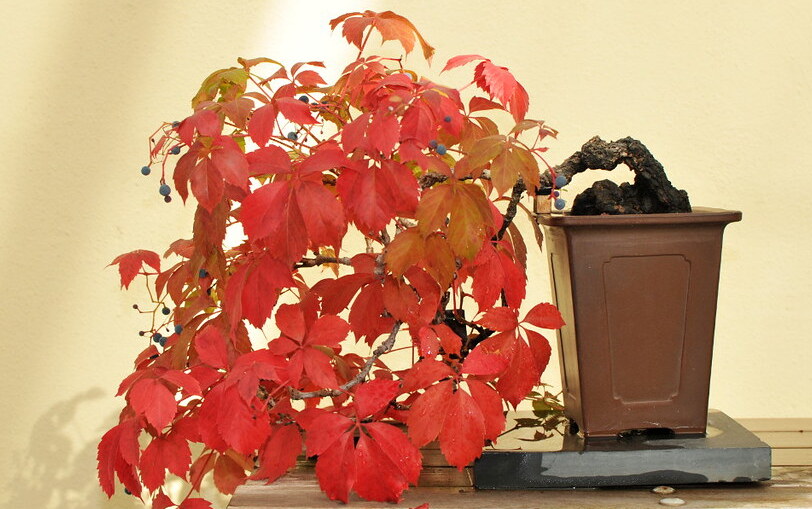
Characteristics of the Virginia Creeper Bonsai
The Virginia Creeper Bonsai has a few unique qualities that add to its appeal and make it an interesting choice for bonsai fans. Here are some things about the Virginia Creeper Bonsai that stand out:
Leaves: The leaves of Virginia Creeper are well-known for being beautiful. Each leaf is split into five parts that look like the fingers of a hand. During the growth season, the leaves are a bright green color that makes the plant look full and healthy. In fall, the leaves change into beautiful shades of red, orange, and purple, giving the bonsai a beautiful splash of color.
Climbing Habit: In its natural habitat, Virginia Creeper is a climbing vine that attaches itself to various surfaces using adhesive tendrils. When cultivated as a bonsai, this climbing habit can be artistically represented through the careful arrangement of branches and trained growth patterns, creating a sense of vertical movement and visual interest.
Trunk: Over time, the wood of a Virginia Creeper Bonsai gets a rough and old look. Its bark is a dark brown color and has small cracks and ridges that add to the tree’s personality and make it look like an old tree in nature.
Size: Virginia Creeper Bonsai is typically smaller in size compared to its full-grown counterparts in the wild. The bonsai artist carefully selects and cultivates Virginia Creeper specimens with a suitable trunk diameter and proportions that are proportionate to the desired size of the bonsai.
Fall Color Display: The bright fall leaves of the Virginia Creeper Bonsai are one of its most beautiful parts. As the seasons change, the leaves change to beautiful red, orange, and purple colors. This sudden change in color makes the bonsai look beautiful and adds a dynamic element to its overall beauty.
Resilience: Virginia Creeper is known for being hardy and able to grow in a variety of places. It can grow in a wide range of weather, and pests and diseases don’t bother it much. This makes it good for growing as a bonsai because it can handle the rare stresses of cutting, shaping, and training.
The Virginia Creeper is a great choice for bonsai lovers because of its unique leaf structure, growing habit, trunk features, and color changes throughout the year. Its adaptability, beauty, and hardiness make it a popular species for bonsai. This lets bonsai artists make tiny trees that are both beautiful and interesting to look at.
How to Grow a Virginia Creeper Bonsai
Growing a Virginia Creeper Bonsai can be a rewarding and enjoyable experience. Here are the steps to guide you in cultivating and nurturing your own Virginia Creeper Bonsai:
Selecting a Healthy Specimen:
- Choose a Virginia Creeper plant that has a strong and healthy root system, as well as a sturdy trunk.
- Look for a specimen with vibrant and well-formed leaves, indicating its vitality.
Potting and Soil:
- Use a well-draining bonsai pot with adequate drainage holes.
- Prepare a suitable soil mix, consisting of a blend of well-draining components like akadama, pumice, and organic matter such as bonsai soil or compost.
- Place a layer of drainage material (such as bonsai gravel or mesh) at the bottom of the pot to ensure proper drainage.
Pruning and Shaping:
- Begin pruning your Virginia Creeper Bonsai during the dormant season (winter or early spring) to promote new growth.
- Trim away any dead, damaged, or excessively long branches to maintain the desired shape and form.
- Use pruning shears or bonsai scissors to carefully prune, ensuring clean cuts.
Wiring and Training:
- Wiring can be used to shape and position branches in desired positions. Use bonsai wire wrapped gently around the branches, being careful not to damage the bark.
- Train the branches gradually over time, bending them into the desired shape while considering the natural growth patterns of the Virginia Creeper.
Watering:
- Provide regular watering to keep the soil consistently moist but not waterlogged. Avoid allowing the soil to dry out completely between waterings.
- Ensure proper drainage by allowing excess water to drain out from the drainage holes.
- Adjust the frequency and amount of watering based on the climate, season, and specific needs of your Virginia Creeper Bonsai.
Sunlight and Temperature:
- Virginia Creeper Bonsai thrives in full sun to partial shade. Place your bonsai where it receives ample sunlight for optimal growth and foliage coloration.
- Protect the bonsai from extreme temperature conditions, especially frost or intense heat, as it can negatively affect the plant’s health.
Fertilization:
- Feed your Virginia Creeper Bonsai with a balanced bonsai fertilizer during the growing season (spring to early autumn) to promote healthy growth.
- Follow the manufacturer’s instructions regarding the dosage and frequency of fertilization.
Repotting:
- Repot the Virginia Creeper Bonsai every two to three years, during early spring before the new growth begins.
- Trim and prune the roots during repotting, removing any tangled or overly long roots.
- Replace the old soil with fresh bonsai soil mix, ensuring proper drainage and nutrient availability.
Pest and Disease Control:
- Regularly inspect your Virginia Creeper Bonsai for any signs of pests, such as aphids or spider mites.
- If pests are present, use appropriate measures like insecticidal soaps or horticultural oils to control the infestation.
- Take preventive measures to maintain a clean and healthy environment for your bonsai, which includes good ventilation and proper hygiene practices.
Observation and Care:
- Regularly observe your Virginia Creeper Bonsai for any changes in growth, leaf color, or overall health.
- Adjust your care routine based on the specific needs and responses of your bonsai.
- Stay attentive to its watering, pruning, and maintenance requirements to ensure its well-being and longevity.
Training the Climbing Habit:
- As the Virginia Creeper is a climbing vine by nature, you can use training techniques to guide its growth.
- Attach the main stem or branches to a trellis or support structure, allowing them to climb and weave their way upwards.
- Gently secure the stems using soft ties or plant-friendly materials to prevent damage or constriction.
Seasonal Care:
- During the dormant period (winter), reduce watering and refrain from fertilizing. This allows the bonsai to rest and prepare for new growth in the following season.
- As spring approaches and new growth emerges, resume regular watering, fertilizing, and maintenance activities.
Leaf Pruning:
- To maintain the desired shape and balance of your Virginia Creeper Bonsai, perform leaf pruning when necessary.
- Remove any excessive growth or crowded leaves to improve air circulation and promote healthy foliage.
Winter Protection:
- Protect your Virginia Creeper Bonsai from freezing temperatures during winter, especially if it is exposed to harsh conditions.
- Consider placing the bonsai in an unheated but sheltered location, such as a garage or shed, to shield it from extreme cold.
Continuous Learning:
- Bonsai is an art form that requires ongoing learning and experimentation.
- Explore bonsai books, attend workshops, or join bonsai clubs to enhance your knowledge and exchange experiences with other enthusiasts.
By following these rules and giving your Virginia Creeper Bonsai the care it needs, you can enjoy its beauty and watch it grow as it gets older. Remember to be gentle, watch how it acts, and change your care based on what you see. Growing a Virginia Creeper Bonsai is a satisfying process that lets you watch a simple plant turn into a live piece of art.
Benefits of the Virginia Creeper Bonsai
The Virginia Creeper Bonsai offers several benefits beyond its aesthetic appeal. Here are some advantages of cultivating a Virginia Creeper Bonsai:
1. Stress Relief: Taking care of a Virginia Creeper Bonsai can be relaxing and soothing, just like taking care of any other bonsai tree. Taking care of a bonsai by doing things like cutting, feeding, and shaping it can help you feel calm and in the moment.
2. Indoor and Outdoor Flexibility: Virginia Creeper Bonsai can be grown both inside and outside, which gives you options for where to put them. It can live on a windowsill, rooftop, patio, or in a garden, so bonsai fans with limited room can still enjoy the beauty of a bonsai tree.
3. Natural Air Purifier: The Virginia Creeper Bonsai is a live plant that helps clean the air by taking in carbon dioxide and giving off oxygen. This can help improve the air quality around the tree, making the area around it a better place to be.
4. Connection with Nature: People can connect with nature on a smaller scale by growing a Virginia Creeper bonsai. It gives you a sense of caring and duty as you tend to the bonsai tree and watch it grow and change.
5. Artistic Expression: Virginia Creeper Bonsai, like all bonsai plants, is an art form unto itself. It lets people who like bonsai show their imagination and artistic vision by shaping and training the tree to get a certain look. It gives people a place to express themselves and appreciate the beauty of nature.
6. Educational Value: Growing and caring for a Virginia Creeper Bonsai is a chance to learn about gardening, plant biology, and the art of bonsai. It motivates people to keep learning and gives them a deeper understanding of how to care for plants, how to prune them, and the whole gardening process.
7. Conversation Starter: People often stop and look at a Virginia Creeper Bonsai because of its unique beauty and charm. It helps you start a talk about how much you love bonsai and the art that goes into making and taking care of these small trees.
8. Longevity and Legacy: With proper care and attention, a Virginia Creeper Bonsai can live for many years, even decades. It becomes a living legacy that can be passed down through generations, carrying the memories and appreciation for bonsai cultivation.
Overall, the Virginia Creeper Bonsai provides therapeutic advantages, educational possibilities, and a connection to nature in addition to visual delight. It brings the beauty of nature into your home, resulting in a sense of calm and personal contentment.
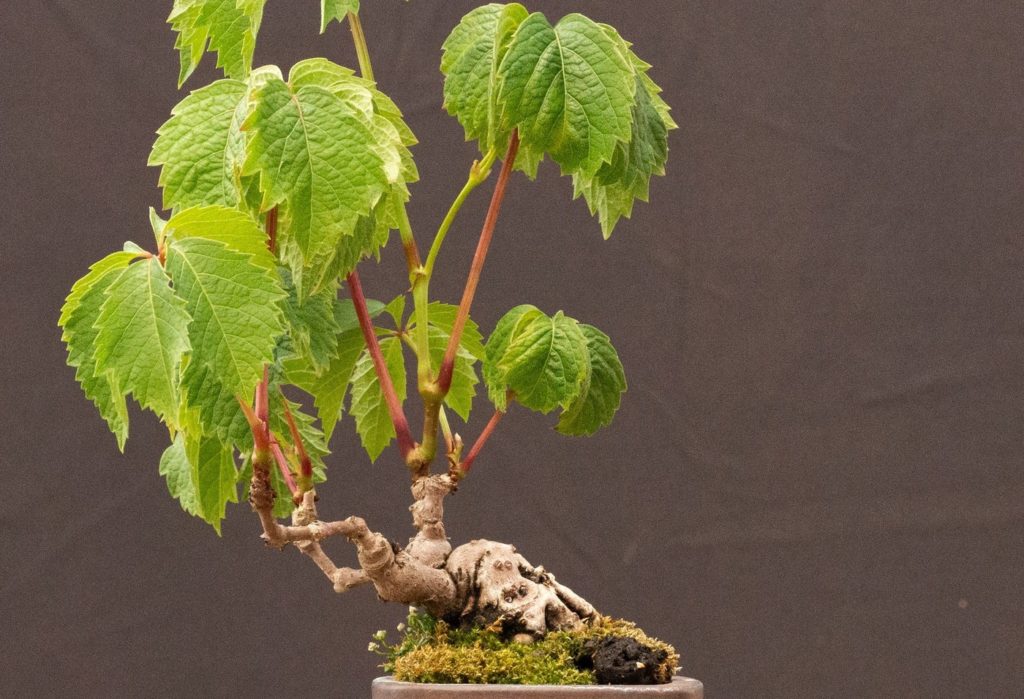
Displaying Virginia Creeper Bonsai
Displaying your Virginia Creeper Bonsai in an appealing and appropriate manner is essential to showcase its beauty and create an aesthetically pleasing arrangement. Here are some considerations for displaying your Virginia Creeper Bonsai:
- Bonsai Stand or Table: Put your Virginia Creeper bonsai on a bonsai stand or table to raise it and give it a stable place to show off. Make sure that the stand or table matches the style and design of the bonsai as a whole.
- Lighting: Place your bonsai where it will get enough light, either from the sun or from lights. Virginia Creeper Bonsai needs bright, indirect sunlight to grow well. Don’t leave it in full sunlight for long amounts of time, as this can burn the leaves.
- Background: Choose a background that makes the tree look better and goes with it. A simple wall or background in a neutral color can help the form and leaves of the bonsai stand out. Use a color that is different from the others to make the tree stand out.
- Balance and Proportion: Keep your show balanced and in the right amount. Think about how big the bonsai is in relation to where it will be displayed. It shouldn’t be too big or too small. Add rocks, plants that stand out, or small models that go well with what you already have to make a pleasing whole.
- Seasonal Accents: Add seasonal touches to the Virginia Creeper Bonsai to show off its natural beauty and how it changes over time. For example, around the base of the bonsai, you can add small decorations like tiny pumpkins or leaves in fall colors to fit the season.
- Viewing Angle: Your Virginia Creeper bonsai should be set up at an angle that makes it easy and fun to look at from different points of view. You might want to turn the shrub every so often to show off different parts of its shape and leaves.
- Indoor vs. Outdoor Display: Depending on the weather and what your Virginia Creeper Bonsai needs, you can put it on show indoors or outdoors. Indoor displays give you more control over the lighting and surroundings, while outdoor displays give you a more natural, open setting.
- Protection: If you put your Virginia Creeper Bonsai outside, protect it from things like heavy rain, strong winds, and long periods of direct sunlight. During bad weather, you may want to cover or protect something.
- Regular Maintenance: Keep your display space clean and clear of dust and clutter. Inspect the bonsai on a regular basis for symptoms of pests or illnesses and take necessary action to address them as soon as possible.
Remember that your Virginia Creeper Bonsai exhibit should represent your particular style and originality. Experiment with various arrangements and styles to discover the one that best highlights the unique traits of your bonsai while being consistent with your desired aesthetic.
Styling and Design of a Virginia Creeper Bonsai
A Virginia Creeper Bonsai’s style and design entail shaping and training the tree to obtain a visually pleasing form that highlights its distinctive traits. Here are some ideas for arranging your Virginia Creeper Bonsai:
Informal Upright Style (Moyogi): This design is distinguished by a slightly curved trunk with a natural and organic look. Aim for a subtle S-curve in the trunk to replicate the Virginia Creeper’s beautiful growth pattern in nature.
Cascade Style (Kengai): Allowing the main trunk to fall downhill creates a fluid and dramatic look in the cascade style. You may train the Virginia Creeper’s branches to flow over the side of the bonsai pot, suggesting a vine tumbling over a cliff.
Semi-Cascade Style (Han-Kengai): In this style, the trunk is slanted, but not as dramatically as in the cascade style. The branches typically cascade slightly below the rim of the bonsai container, creating an elegant and balanced appearance.
Multi-Trunk Style (Ikadabuki): The Virginia Creeper is a good choice for the multi-trunk style of bonsai because it naturally spreads and grows more than one stem. Arrange the stems in a way that looks good, making sure they spread out from the base and show off the fissured bark.
Clump Style (Yose-ue): In the group style, you put several Virginia Creeper plants together to make it look like a small grove or forest. Set up the stems and branches in a way that is orderly and balanced, making sure that each plant keeps its own shape.
Branch Placement and Direction: Think about how the Virginia Creeper grows naturally and order the branches that way. Let some branches grow up, and train others to grow out horizontally. This will make a cover that is open and airy.
Negative Space: Use empty space in the design to give it depth and make it more interesting to look at. Leave space between the branches to make it look like the tree is older and more mature, which is how the Virginia Creeper grows on its own.
Pruning and Leaf Reduction: To keep the bonsai in the shape you want, you must prune it regularly. Cut back too much growth and long stems to encourage back-budding and encourage growth that is close together. Also, methods like defoliation or selective leaf trimming can be used to get rid of leaves and make the tree look better overall.
Wiring: Use bonsai wire to bend the branches and move them in the direction you want. Be careful when wiring the Virginia Creeper because its branches are thin and easily broken. Make sure the wire is put on carefully and keep an eye on the growth to avoid wire marks.
Pot Selection: Choose a bonsai pot for your Virginia Creeper Bonsai that fits its style and size. Think about using earthy tones or basic colors to make the tree and the pot look good together.
Remember that styling a Virginia Creeper Bonsai is an ongoing process that takes patience and careful observation. Check on the tree’s growth often and make changes as needed. Give the bonsai time to grow up and develop its own personality.
How to Care for and Maintain a Virginia Creeper Bonsai
Caring for and maintaining a Virginia Creeper Bonsai involves several essential tasks to ensure its health, growth, and longevity. Here are some care guidelines to keep in mind:
- Watering: Virginia Creeper Bonsai likes dirt that is wet all over. Make sure the water gets to the roots when you water the shrub. Don’t water too much, because too much water can cause root rot. Check the amount of moisture by seeing how wet the dirt is before you water again.
- Sunlight: Give your Virginia Creeper Bonsai a lot of sun. Put it somewhere where it will get full or partial sun, preferably at least 4–6 hours of straight sunshine per day. If the leaves start to wilt or get burned from too much sun, move the plant.
- Temperature and Humidity: Virginia Creeper Bonsai can live in a wide range of temperatures, but it does best in mild temperatures between 60 and 80°F (15 and 27°C). Protect the bonsai from extreme heat or cold by offering shade or cover when needed. Mist the plants every once in a while, especially if they are in a dry room.
- Fertilization: During the growing season (spring to early fall), feed your Virginia Creeper Bonsai with a balanced, slow-release bonsai fertilizer. Follow the directions from the maker for the right amount to take and how often. During the dormant time (winter), cut back on or stop fertilizing.
- Pruning and Trimming: Your Virginia Creeper Bonsai needs to be pruned often to keep its shape, size, and health. Get rid of any dead, sick, or crossed limbs to let more air through. Cut back long buds to support growth that is branching and close together. Cut away extra leaves to keep the roof in balance.
- Wiring and Shaping: Wiring can be used to bend and move branches in the way you want. When wiring a Virginia Creeper, be careful because its branches can be weak. Use soft or bendable wire and check for wire marks often to keep the bark from getting hurt. If wires are left in place for too long, they may leave scars.
- Repotting: Every two to three years, you should repot your Virginia Creeper Bonsai, especially in the early spring before the new growth starts to show. Use bonsai soil that drains well, and cut away any roots that are circling or twisted. Cut back too much greenery to make up for the loss of roots. Repotting helps the roots grow well and keeps the bonsai from getting too big for its pot.
- Pest and Disease Control: Check your Virginia Creeper Bonsai for pests like aphids, spider mites, and scale insects on a regular basis. Use insecticidal soaps or garden oils to get rid of any pests right away. Pests and diseases are less likely to happen when preventive steps are taken, like keeping things clean and checking on them often.
- Winter Care: Virginia Creeper Bonsai can survive in cold weather, but in harsh winters, they may need to be protected. Put the tree in a place that doesn’t get warm but is protected from the cold, like a garage or cold frame. Don’t let the temperature of the bonsai change quickly.
- Regular Observation: Keep an eye on your Virginia Creeper Bonsai’s general health and how it looks. Keep an eye out for signs of worry, illness, or bugs. Change your care routine based on what your bonsai needs and how it responds.
Remember that taking care of a Virginia Creeper Bonsai means giving it regular care and changing to meet its needs. Regular care, like feeding, cutting, and protecting your bonsai, will help it grow and stay beautiful over time.
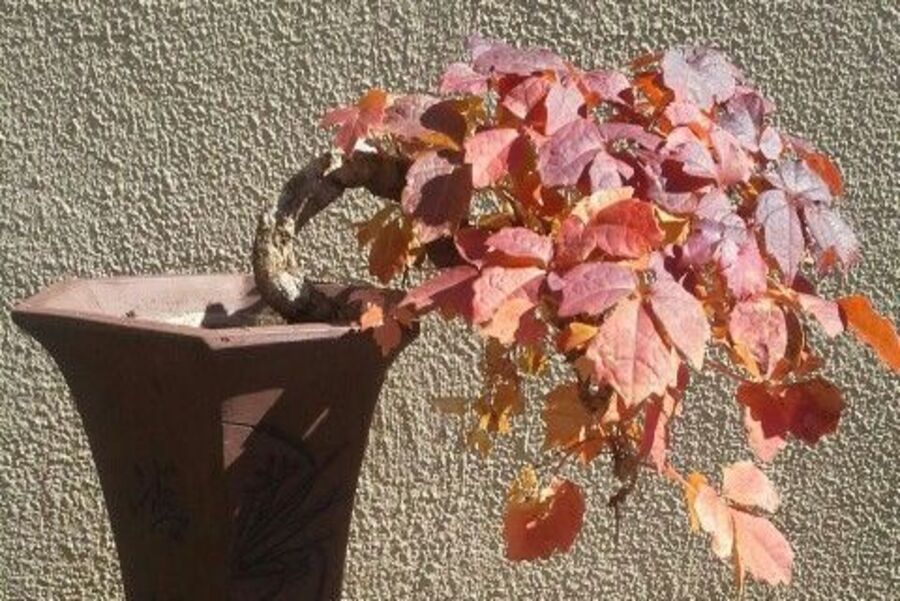
Virginia Creeper Bonsai Care Sheet
| Aspect | Care Tips |
| Watering | Keep soil evenly moist, avoiding overwatering. |
| Check soil moisture before watering again. | |
| Sunlight | Place in a location with full to partial sun (4-6 hours of direct sunlight per day). |
| Temperature | Moderate temperatures between 60-80°F (15-27°C) are ideal. |
| Humidity | Maintain adequate humidity levels by misting the foliage occasionally. |
| Fertilization | Use balanced, slow-release bonsai fertilizer during the growing season. |
| Follow manufacturer’s instructions for dosage and frequency. | |
| Pruning and Trimming | Regularly prune dead, diseased, or crossing branches to improve air circulation. |
| Trim long shoots to encourage branching and compact growth. | |
| Wiring and Styling | Use wiring to shape and position branches carefully, avoiding wire marks. |
| Repotting | Repot every 2-3 years in well-draining bonsai soil during early spring. |
| Trim roots and foliage to maintain a balanced root-to-shoot ratio. | |
| Pest and Disease Control | Regularly inspect for pests (aphids, spider mites, scale insects) and treat as necessary. |
| Use insecticidal soaps or horticultural oils for infestations. | |
| Winter Care | Protect from severe cold by placing in a sheltered location (garage, cold frame). |
| Regular Maintenance | Monitor overall health and appearance regularly. Adjust care routine based on observations. |
Make sure to change these care tips based on how your Virginia Creeper Bonsai grows and what it needs. Your bonsai will stay healthy and strong if you look at it often and pay attention to what it needs.
Conclusion:
Virginia Creeper Bonsai offers a delightful way to bring the beauty of nature into your home or garden. With proper care and attention, you can enjoy the mesmerizing foliage and intricate design of this captivating bonsai tree. So, start your bonsai journey with Virginia Creeper and immerse yourself in the joy of cultivating and appreciating this unique plant.
FAQ:
Q: What is a Virginia Creeper Bonsai?
A: Virginia Creeper Bonsai is a miniature tree created from the Virginia Creeper (Parthenocissus quinquefolia) plant, trained and pruned to resemble a fully grown tree in a smaller size.
Q: How big does a Virginia Creeper Bonsai grow?
A: When fully grown, Virginia Creeper Bonsai can reach a height of 6 to 18 inches (15 to 45 cm), depending on age and training.
Q: Can I keep a Virginia Creeper Bonsai indoors?
A: Yes, Virginia Creeper Bonsai can be kept indoors. However, it is important to provide adequate sunlight and maintain appropriate humidity levels to ensure its health and growth.
Q: How often should I water my Virginia Creeper Bonsai?
A: Watering frequency may vary depending on factors such as climate, pot size, and soil. Generally, it is recommended to water when the soil starts to feel slightly dry, ensuring that the roots receive adequate moisture without becoming waterlogged.
Q: Does a Virginia Creeper Bonsai require pruning?
A: Yes, regular pruning is necessary to maintain the desired shape and form of a Virginia Creeper Bonsai. Pruning helps control growth, remove dead or unhealthy branches, and promote compactness.
Q: Can I wire and shape the branches of a Virginia Creeper Bonsai?
A: Yes, you can wire and shape the branches of a Virginia Creeper Bonsai. However, caution must be exercised as the branches of Virginia Creeper are delicate. Use soft or flexible wire, and regularly check for wire marks to avoid damaging the tree.
Q: When should I repot my Virginia Creeper Bonsai?
A: Virginia Creeper Bonsai should be repotted every 2 to 3 years, preferably during the early spring before new growth begins. Repotting helps refresh the soil, prune the roots, and promote healthy growth.
Q: What pests or diseases should I watch out for with Virginia Creeper Bonsai?
A: The Virginia Creeper Aphids, spider mites, and scale insects are common pests of bonsai. Inspect your bonsai on a regular basis for symptoms of infestation and apply appropriate pest management techniques, such as using insecticidal soaps or horticultural oils.
Q: Does a Virginia Creeper Bonsai lose its leaves in winter?
A: Yes, Virginia Creeper Bonsai is deciduous and will shed its leaves in winter. This is a natural process, and the tree will grow new leaves in spring.
Q: How long can a Virginia Creeper Bonsai live?
A: With proper care and maintenance, a Virginia Creeper Bonsai can live for several decades, providing years of enjoyment and beauty.
Also Read:



